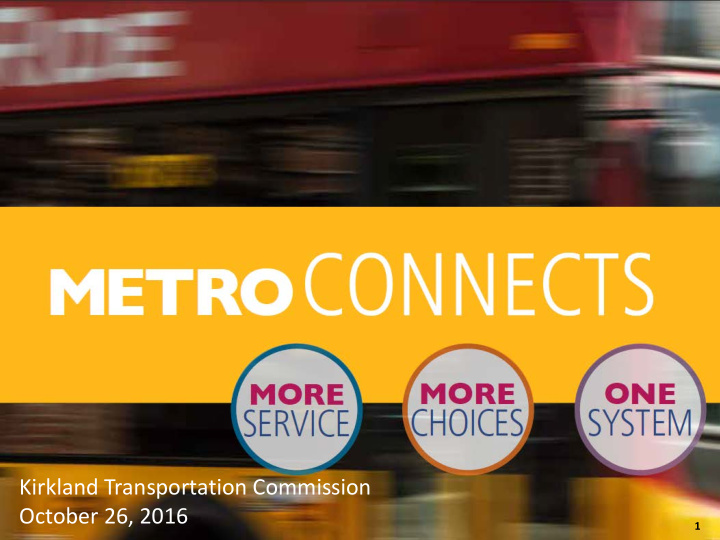



Kirkland Transportation Commission October 26, 2016 1
Why now? By 2040 our region will increase by: What will it take to respond to these needs? 70% 1m 850k GROWTH in Metro service, from 3.5 million service hours to 6 million hours by 2040. 2
How we got to METRO CONNECTS Redmond TMP Kirkland TMP Where is Transit Going in the Future • Service and Capital requirements • Long-term funding needs How will transit support local development? Federal Way Comp Plan Shoreline Comp Plan • Land use/density decisions • TOD development • ROW decisions & Prioritization • Regional coordination • Competitive grant applications 3
METRO CONNECTS Outreach 4
What is METRO CONNECTS “ This vision is intended to be our atlas as we create an integrated transportation system that connects people to opportunity, protects our environment, and knits together our growing cities. ” – King County Executive Dow Constantine More frequent service On demand travel • 26 RapidRide lines and more frequent service • Evolving options accessible from you smartphone All-day service Improved access to transit • Express buses, running every 15 to 30 minutes • Easier and safer ways to get drive, walk, or bike to transit More local service Partnerships and Coordination • Regular routes and community tailored options • Work closely with cities and transit agencies Investments to make travel faster Behind-the-scenes investments • Make transit faster, more reliable and efficient • Expand fleet and service needs to support our vision 5
METRO CONNECTS Vision More Service, More Choices • An expanded network of frequent service - 73% of residents would be within ½ mile of frequent service • 26 RapidRide lines • A growing network of all-day express buses • More local service – bus routes and new transportation options • Better, safer access to transit • Roadway improvements to make transit fast and reliable 6 6
One easy-to-use system • Well connected and efficient with smooth transfers between buses and light rail • Where many more people would be able to get to Link in 15 minutes by walking or by bus. • A system that everyone can use – including new options for people with disabilities, better signs and wider aisles and doors 7 7
Service Network 8
How Service Changes 1.4 6.0M 1.1 0.5 4.1 4.4M 1.2 3.5M HOURS 2.8 1.9 0.4 HOURS HOURS 0.5 2025 2015 Split of Service Hours 2040 2015 2025 2040 Total 100% 100% 100% Frequent 53% 64% 68% Express 14% 10% 9% Local 33% 26% 23% 9
Improving Service Quality • Speed and Reliability High Low Medium • Boarding and Fares • Innovation and Technology • Customer Communications • Passenger Facilities • Access to Transit • Managing Demand • Transit-Oriented Development 10
Critical Service Supports • Fleet: 625 additional buses Incremental Capital Investments 2018-2040 needed by 2040 • Layover Areas: Increase layover spaces by 50% by 2040 • Operations and System Preservation: Invest in building and maintaining infrastructure • Metro’s Workforce: Expand our skilled workforce 11
How far you can go Starting from: Downtown Kirkland In the year: 2016 2025 2040 15 minutes 30 minutes 45 minutes 60 minutes Travel times include initial wait times and the average time spent waiting to transfer. Represents trips starting at noon on weekdays.
How far you can go Starting from: Downtown Kirkland In the year: 2016 2025 2040 15 minutes 30 minutes 45 minutes 60 minutes Travel times include initial wait times and the average time spent waiting to transfer. Represents trips starting at noon on weekdays.
How far you can go Starting from: Downtown Kirkland In the year: 2016 2025 2040 15 minutes 30 minutes 45 minutes 60 minutes Travel times include initial wait times and the average time spent waiting to transfer. Represents trips starting at noon on weekdays.
How will we implement the plan • Uses METRO CONNECTS to guide project planning and scoping for 2025 • Improves internal and external coordination • Provides framework and tools to organize work to: – Facilitate partnerships – Build case for grants – Help inform biennial budgets 15
How we will work with jurisdictions Continue work of METRO CONNECTS • Continue individual jurisdictions conversations with staff and elected officials • Meet regularly with regional technical advisory committees (TAC) • Develop project goals, priorities, and timing • Identify partnership projects and other areas for increased collaboration • Establish project implementation timeline 16
Kirkland Service Examples Current 2025 Network 17
Questions? Contact us: Graydon Newman Transportation Planner Graydon.Newman@KingCounty.gov 206-477-5862 Tristan Cook Community Relations Planner Tristan.Cook@KingCounty.gov 206-477-3842 18
Recommend
More recommend